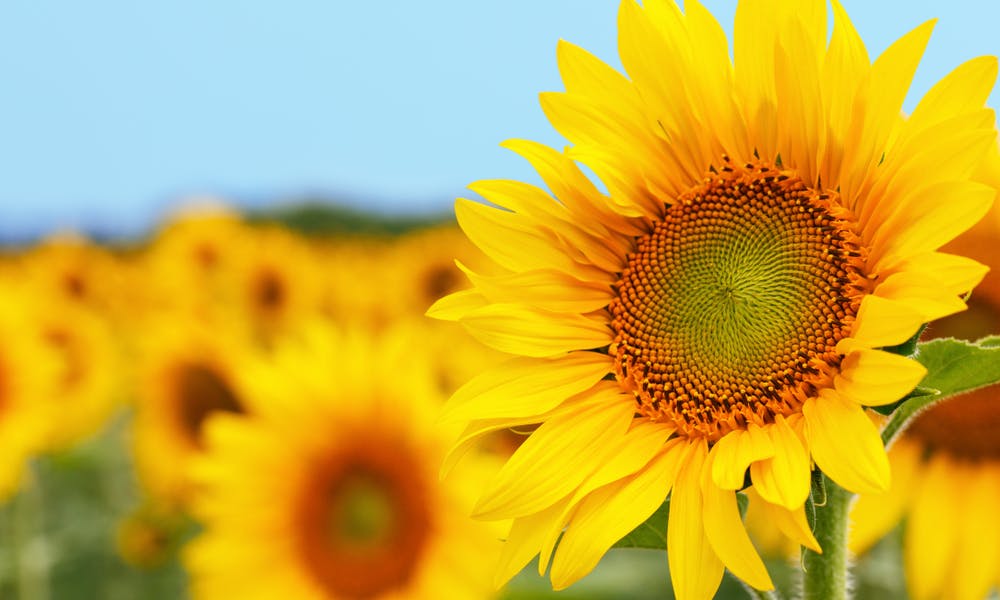MENU
Sunflower Meanings

The cheerful sunflower, with its large, yellow flower petals is a mainstay of many gardens and can be found blooming in parks and forests all over the Americas. With its seeds gracing the snack bags of children and adults the world over, there are very few flowers as well known, or as tasty, as the sunflower. Time for some exploration into this useful flower’s history and all the fun and interesting meanings that have been ascribed to it over the years.
Keep on reading to find out:
- The History of the Sunflower
- Sunflower Specs
- Greek Myths
- Cultural Meaning
- Religious Symbolism
- Meaning in Chinese Culture
- Native American Symbolism
- Sunflower Seeds
- Raising a Sunflower
The History of the Sunflower
The sunflower, known in scientific circles as the Helianthus, is a genus composed of nearly 70 species of plants. Almost all the sunflower species known are found in Central and North America, with only a few residing in South America. In Mexico and the Southern United States, the sunflower was domesticated by the native Americans around 1,000 years ago, who raised the flower as a crop for food and other items. In the early 16th century, it was brought back to Europe by explorers. Fossilized remains have been found in North America dating as far back as 3,000 years ago. New varieties are being cultivated yearly, with some beautiful red variations being produced recently, such as the red sun.
Sunflower Specs
Some species of sunflowers are annual while others are perennial. They tend to grow quite tall, with some species growing as tall as 300 cm or even higher. Bearing one or more flower heads, with generally flashy yellow florets that resemble the shape of a heart, the sunflower petals are composed of hundreds, if not thousands, of small, gorgeous blooms that cluster together around a base of seeds. Those seeds, hermaphrodite in nature, can self-pollinate or attract pollen from the surrounding flowers and with the help of insects. While growing, they typically lean towards the sun, which when combined with their bright exteriors has led to their receiving their name. The stem of the plant is quite rough and hairy, although the domestic sunflowers are starting to lose the trait.
Greek Myth
The sunflower has many stories attributed to it, one of which stems from Greece. There is an old Greek myth that tells of a nymph by the name of Clytie who fell in love with the sun god Apollo. In time, Apollo lost interest in her and fell in love with another nymph. When Clytie discovered this, she became very jealous and told the other Nymphs father, who in a rage, buried her alive. When Apollo found out, he turned Clytie into a flower, and she spent the rest of eternity gazing after him in adoration as he moved across the sky, hence her namesake sunflower.
Cultural Meaning
In popular culture, the sunflower has a variety of symbolic meanings. It relates to feelings of warmth, happiness, and a generally positive outlook on life. Due to its association with the sun, many people ascribe the values of strength and power to it as well. It has also been connected to feeling of admiration and loyalty between friends and family.
Religious Symbolism
Some spiritualist churches use the sunflower as their insignia. In ancient Christianity, the sunflower was thought to represent a members unwavering belief and dedication to the church and God, as well as God’s love for all his believers.
Meaning in Chinese Culture
Within Chinese culture, the sunflower has come to represent good luck, and receiving one as a gift or simply walking by one is seen as an auspicious sign. The yellow color is thought to denote intelligence as well as a vital spirit. In ancient China, royalty would eat the sunflower as a way to gain immortality, and it has continued to be associated with long life and prosperity. Most of China considers it a symbol of happiness as well.
Native American Symbolism
The Native Americans commonly used the sunflower in their summer festivals to symbolize the harvest and its bounties and was often associated with the sun and fertility.
Sunflower Seeds
Packed full of vitamins such as calcium, vitamin E, Selenium, and other important nutrients, the sunflower seed is one of the world’s most popular snacks. With a light, nutty flavor, they are perfect raw but can be roasted as well. There is some research suggesting that they can help with diabetes and high blood pressure. Sunflower oil is a very popular cooking oil pressed from the seeds of the sunflower. Mainly composed of monounsaturated and polyunsaturated fats, it is produced extensively in the Ukraine and Russia. Almost 20 million tons of sunflower seed oil is produced annually.
Raising a Sunflower
As their name implies, the sunflower does best with a lot of sunlight. They can grow in moist soil so long as it is not overdone. If you are planting them in a garden with other food be wary, as they release chemicals that can inhibit the growth of other plants. The flowers do not require fertilizing, although in the early growth stages a nice layer of mulch helps with the loss of moisture and to keep away pesky weeds. When planting the seeds, make sure to give each a wide space, as they can grow quite tall. Sunflowers can reach full maturity within as little a timeframe as six months, so keep an eye on them to adjust your setup.
The Cheery Sunflower
Whether you want to light up your garden with its bright yellow flowers, show off to your gardener friends about how much taller yours are, or simply have fallen in love with their delicious seeds and want to have your own supply in case the zombies finally come calling, the sunflower is a wonderful companion to include in your garden.

